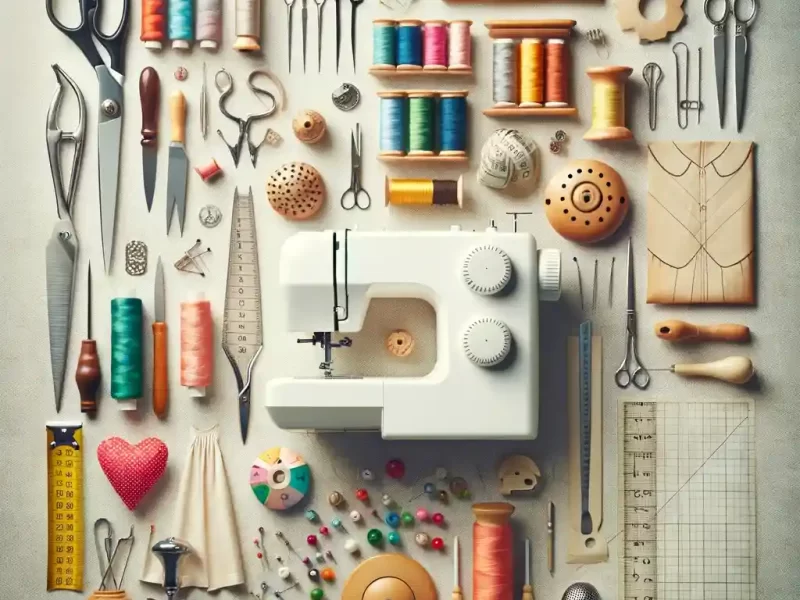Ah, sewing! That age-old craft weaving tales of heritage and creativity. Remember the joy of crafting your first hand-stitched project? It’s a thrill unlike any other. In this digital era, introducing a child to the tactile delight of sewing can be a refreshing escape. It’s more than just threading a needle; it’s about weaving stories, nurturing patience, and sparking imagination.
Think about the twinkle in a child’s eyes when they hold up their first handmade masterpiece. That’s pure, unfiltered pride. As screens pull our attention in a million directions, sewing can be that hands-on activity grounding us, connecting generations, and kindling creativity.
Dive in with me, as we unravel these 10 smart tips. Whether you’re reigniting a family tradition or charting new creative waters, the journey promises to be as memorable as the destination. Ready to stitch some memories? Let’s go!
Understanding the Right Age to Start:
Every child blossoms at their own pace, but when it comes to sewing, certain skills and developmental markers can give us a clue. So, how do you gauge the right age to start? Let’s dive into the details! 🕵️♀️✨
🧠 Factors that determine a child’s readiness for sewing:
- Curiosity & Enthusiasm: Remember the time when your kiddo tried to wear your shoes and walk around? 🥿 Or when they expressed the wish to help out in the kitchen? Similarly, a child expressing interest in sewing is a great first indicator. If they’re curious about the colorful threads, enchanted by the sewing machine’s hum, or just want to mimic you, it’s a sign! 🌟
- Attention Span: Patience is key in sewing. Can your child sit and focus on a task for a good 10-15 minutes? If yes, it’s a green signal. Think of those times they’re engrossed building a LEGO castle or coloring a masterpiece. If they can focus on those, they might be ready for some stitchy business! 🧵🏰
- Listening & Following Directions: Sewing requires attention to safety and understanding of instructions. If your child listens well when you read them a story or follows game rules, it’s a hint they might be ready to follow sewing instructions too. 📖➡️🪡
🖐 Basic motor skills required:
- Pinching & Grasping: Can they pick up small objects like beads or buttons with ease? This skill is vital as it mirrors how they’d hold a needle. Remember those adorable moments when they tried picking up that one elusive pea from their plate? That’s the kind of skill we’re talking about! 🍴🪡
- Hand-Eye Coordination: Think of the times they threaded pasta necklaces or laced their shoes. If they can do these, they’re developing the coordination needed for sewing. 🍝➡️👟➡️🪡
- Steadiness: While a little wobbly hand is super cute, for sewing, we want those tiny hands to be a tad steady. Can they draw or trace without much wobble? That’s a good sign for their sewing readiness. ✍️🙂
In conclusion, while age is a factor, it’s more about where they are developmentally. Some kids might be ready as young as 4, while others might shine brightest at 7 or 8. Watch for these signs, and when the time is right, embark on the magical sewing journey together! 🌈🧵🚀
Safety First: 🚫✂️🪡
Embarking on a sewing journey with your little one is nothing short of magical! But like every superhero tale, every stitch story needs its safety protocols. Let’s unravel these, so our kiddo stitch-masters can create with confidence and care! 🌟🦸♂️
✨ Introducing Safety Rules:
- Needle Know-How: 🪡
- Always return the needle to its cushion or holder.
- Remember how we say ‘Don’t run with scissors’? The same goes for needles! No running, jumping, or dancing with it in hand.
- A neat trick is to make a “Needle Parking Spot” – a fun, designated space where needles rest when not in use. Think of it as the needle’s cozy little home! 🏡
- Scissor Safety: ✂️
- Open scissors slowly and close them after every use.
- No wild scissor adventures! They stay on the table when not in use.
- Think of scissors as the ‘grown-up’ tool. Just like mommy or daddy’s car keys – we handle them with respect and caution! 🚗
- Sewing Machine Manners: 🪡🌀
- Always ensure it’s turned off when not in use.
- Little fingers should be kept away from moving parts. A fun way to teach this? Tell them the machine is like a gentle giant; it’s friendly but needs its personal space.
- When threading or changing the needle, power off first. Treat it like a sleeping dragon – we don’t want to disturb it! 🐉
👀 The Importance of Supervision:
Even the most careful kids can get distracted (Squirrel! 🐿️). Especially for younger stitch stars:
- Always be around when they’re sewing. Think of it as bonding time!
- Consider investing in beginner-friendly tools, like blunt-tipped scissors.
- Set up their sewing space in a common area, like the living room, so you can keep an eye out while they craft their masterpiece.
Remember, safety doesn’t dampen the fun; it ensures our tiny tailors have endless, injury-free adventures in the land of stitches and fabrics. So, gear up, go forth, and sew safely! 🌈🧵🛡️
Teaching a Child to Sew Made Easy with 10 Smart Tips 🪡✨
Debbie Shore
1. Finding the Right Age: 👧👦
Understanding when to introduce your child to sewing is crucial. While there’s no fixed ‘perfect age,’ some children show readiness by 6 or 7, with their fine motor skills developing. Remember how little Timmy mastered using his crayons without scribbling everywhere? That’s a good sign he might be ready to handle a needle and thread! 🖍️➡️🪡
2. Safety First: 🚫✂️
Just as we don’t run with scissors, sewing has its safety rules. Always supervise your little ones, especially around needles, scissors, and sewing machines. A great tip? Make a game out of learning these rules! How about “The Safe Sewing Dance”? 🎵💃
3. Start with Hand Sewing: ✋🪡
Before going full throttle with sewing machines, let kids master the basics with hand sewing. Remember when they first tried tying their shoelaces? This is similar but with colorful threads and cute buttons!
4. Choose the Right Tools: 🧰🖇️
Gift your child beginner-friendly tools. Think large, plastic needles, and soft, colorful fabrics. It’s like moving from jumbo crayons to colored pencils in the world of arts and crafts.
5. Create a Dedicated Sewing Space: 🏰
Carve out a little ‘Sewing Kingdom’ for your young tailor. Having a dedicated space means they can leave projects and return to them, just like their lego sets!
6. Simple Projects to Start: 🌈👜
Remember their first clay pot? Not perfect but priceless! Similarly, let them start sewing with easy projects like bookmarks, headbands, or little pouches. Celebrate every wonky stitch as a milestone!
7. Learning Through Fun Activities: 🎲🪡
Transform sewing lessons into fun games and challenges! How about a ‘Stitch Race’ or a ‘Button Challenge’? Let their imaginations run wild while learning.
8. Patience is Key: ⏳🔑
Just as they took time to master riding a bicycle, sewing is a skill that develops over time. Celebrate small victories and remind them that every great tailor started with a single, uncertain stitch.
9. Join a Kids’ Sewing Group: 🧒🧑🤝🧑
If available, consider joining or creating a kids’ sewing group. They can learn together, share tips, and inspire one another. It’s like a book club but with fabrics and threads!
10. Celebrate and Showcase: 🖼️🎉
Create a ‘Hall of Fame’ in your home to showcase their sewing projects. Every artist needs an audience, and what’s better than the proud display of their creations?
In the end, sewing isn’t just about stitches and fabrics; it’s about weaving memories, building confidence, and creating bonds. So, thread in hand and heart full of excitement, embark on this beautiful journey with your little one. Happy Sewing! 🌟🪡🧵
Frequently Asked Questions
1. At what age can my child start sewing?
While there’s no exact age, many children show readiness to start sewing by ages 6 or 7, depending on their motor skill development. However, always prioritize safety and their interest in the activity.
2. Are sewing machines safe for kids?
Yes, with supervision. There are sewing machines specifically designed for kids that are simpler and have safety features. However, always ensure adult supervision when they’re using one.
3. What are some beginner-friendly sewing projects for kids?
Starting with simple projects like bookmarks, headbands, or small pouches can be encouraging. As they advance, they can move on to more intricate projects.
4. How do I ensure my child doesn’t get hurt while sewing?
Safety is paramount. Always supervise younger children. Begin with safer, child-friendly tools like plastic needles, and ensure they understand the importance of handling tools responsibly.
5. Can sewing be educational for my child?
Absolutely! Sewing can enhance fine motor skills, boost creativity, teach patience, and even introduce concepts of math and geometry through measurements and patterns.
Conclusion
Teaching a child to sew is more than just introducing them to a new hobby; it’s about unlocking a world of creativity, fostering patience, and nurturing an invaluable life skill. While the journey might seem daunting initially, with the right steps, tools, and a lot of patience, it can become an enjoyable bonding activity. 🧵💖
Remember, every child is unique. Some might take to sewing instantly, while others might need a little more time and encouragement. The key is to keep the lessons fun, interactive, and paced according to your child’s comfort. Celebrate the little milestones, whether it’s sewing a straight line or completing their first project. These are the memories and skills they’ll cherish and carry with them throughout their lives. So, grab that fabric, set up your child-friendly workspace, and embark on this beautiful, creative journey together. Happy sewing! ✂️👚

I love sewing, I am sewing for the last 15 years and started this blog with the help of my niece to spread sewing-related guides all over the world.
Sewing could be a full-time profession or hobby, and I wish to make a change by adding more people to the sewing world.


